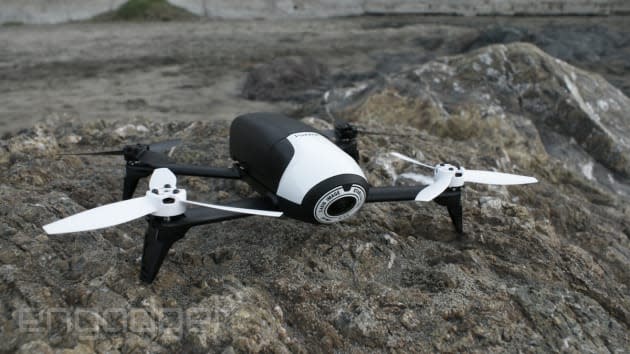Flying a drone is easier when the battery doesn't die right away

It just kept going until it was barely a speck in the sky. I was sure I had lost the Bebop 2 review unit Parrot had sent Engadget. The fact that the company's latest mid-level drone flies longer and faster than its predecessor popped into my mind along side the concern that it would just keep going and going. The onboard 14-megapixel 1080p camera would capture the entire flight. Of course that would be a moot point if it continued on its westward path and eventually lost power and splashed down in the Pacific. I squinted as the sun made it difficult to see the Bebop finally take a quick right turn along its pre-programmed path around San Francisco's Sutro Tower. My concern wasn't completely unfounded: Minutes earlier I had difficulty with the drone's WiFi connection with my phone after powering up. But at the end of the day, the Bebop 2 delivers on its extended battery life and speed even if it takes time to get it up in the air.

The Bebop 2 is an all-in-one solution for anyone looking to graduate from sub-$200 toy quadcopters but doesn't want to shell out for a DJI Phantom 3. While using a smartphone or tablet to fly doesn't give a pilot the same fine command as a dedicated controller with hardware joysticks, after navigating both in my tiny San Francisco apartment and outdoors, getting it to do my bidding became second nature. The 25 minutes of flight time helped with that; after all, it's easier to learn when you're not forced to stop right away.
OK, there were a few crashes. I hit a glass door, a few walls and a rock staircase, and on one occasion lost power while it was 15 feet above wet grass. In each of these incidents, the Bebop shook off the impacts and was ready to fly again. Twice, I did have to bend one of the removable propeller blades back into place. After the impromptu repair, I expected it would be unable to fly correctly. To my surprise, though, it kept hovering in place and flying as commanded.

Unfortunately, WiFi was an issue. About 15 percent of the time, I had difficulty getting the Bebop to connect to my phone or to the optional SkyController before taking flight. I never had the drone lose a connection while flying, but it didn't instill a lot confidence. Indeed, I found myself keeping the drone close by and was particularly nervous about flying over water.
To squelch that fear -- and the reason the drone almost disappeared while circling the highest point in San Francisco -- I paid for an in-app extra called Flight Plan. On the one hand, the fact that Parrot charges $20 for a feature when customers have already paid over $500 for the piece of hardware smacks of nickel-and-diming. Having said that, it's money well spent when you're trying to get footage of an area where line-of-sight just isn't possible and you'd rather let the onboard GPS keep Bebop in the air.

Setting up a flight plan is simple enough, tap a point on a satellite map of the area and choose a flight height and which direction you way you want the drone to point once it gets there. Unlike with WiFi, I never had a problem with GPS. I do wish you could zoom in more on the map for a more precise flight, especially when trying to find a place to land. It would also be nice if there were a "follow me" function so you wouldn't have to worry about waypoints while letting the drone fly on its own. Still, Flight Plan is the feature that'll get you most of the marginally sweet footage from the Bebop.
I say marginally sweet because the footage doesn't deliver on the 14MP promise. Bright days and multiple buildings create issues with the video. One moment the footage seems fine; the next, there's some odd pixelation. It may be the software image stabilization getting confused by all the fine lines. Footage from later in the day looked much better. Still, if you're looking for GoPro quality, you're going to be disappointed. I uploaded a zip file (764MB) of videos directly from the drone's camera so you can see what I mean.

I also tried out the drone with the SkyController which brings the total price up to $800. It extends the WiFi range to over 6,500 feet and the joysticks and hardware buttons make flying the quadcopter a breeze even though you look like a marching band drummer with it's strap around your neck. But it also puts it in the price range of the Phantom 3 with its hardware gimbal and high resolution camera.
Yet another extra expense is a carrying case. Parrot doesn't offer one and you're going to want to protect your drone when it's not flying. Fortunately, once you do get to your destination, putting the removable propellers on is a snap. Throw the battery on the back and with five minutes, you're in the air.
At $550, then, the Bebop is in a weird sweet spot price-wise. It's for someone who wants more than the toys that have flooded the market but tend to be difficult to fly and have horrible cameras, but doesn't want to shell out nearly $1,000 for a professional rig. It's rugged, easy to fly, stays in the air for 25 minutes and the image quality is probably fine for most. Just be sure to make sure your maiden flight plan is a little less ambitious than mine, once this drone is available on December 14th.













